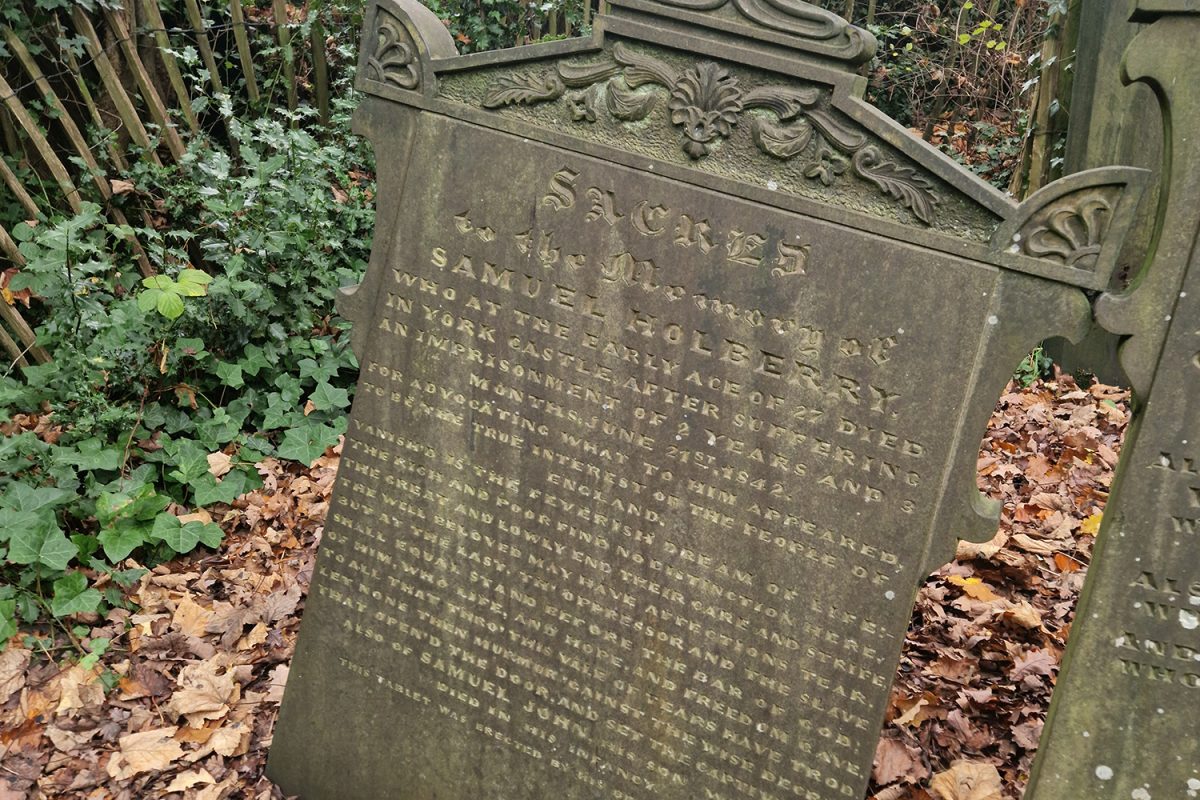Samuel Holberry and Mary Cooper – G 55 Nonconformist
In 1832, the Reform Act was passed giving voting rights to the property-owning middle classes in Britain but excluded most of the working classes, as well as women, from voting. The People’s Charter was published in 1838, a text which became the foundation of a mass movement, calling for huge political reform, including for the right of every man to have the vote, secret ballots, payment for MPs so that ordinary men could afford to stand for election and annual parliaments. It was known as the Chartist movement.
Chartism
Chartism expanded rapidly across the country and gathered support amongst working men and women. Huge rallies were held nationwide. Hundreds of thousands of people signed the Charter, which was presented to Parliament. About a third of these signatories were women. Samuel Holberry was one of the leaders of the Chartist movement in Sheffield. Together with other activists campaigning to extend the political rights given by the Reform Act 1832, he engaged in several peaceful protests. The Sheffield Working Men’s Association was established in December 1837, adopting the People’s Charter which stated that: ‘The working classes produced the rich man’s wealth, while being oppressed by unjust and unequal laws’. The Association’s meetings and demonstrations were well attended and peaceful, but in July 1839 local magistrates banned the gatherings.
Betrayal
In January 1840, Holberry and his companions planned to take over the town hall. The radicals were betrayed, and the police entered the Holberry home and arrested both Mary and Samuel. Mary was pregnant at the time of her arrest. She was locked up for two days and interrogated. She refused to talk and was released without charge. Mary continued to petition for Samuel’s release. The Holberry’s baby, Samuel John was born in May 1840. He died at the age of 18 weeks and is buried in a public grave.
The trial
At the trial, Samuel was not allowed to offer any defence. He was found guilty and sentenced to four years in Northallerton House of Correction. Samuel was illegally made to work a treadmill and his health deteriorated. In 1842, he was transferred to York Castle. Samuel did not want Mary to visit him, knowing that seeing him in prison would be very difficult for her. He wrote to her: ‘My dear, you say you should like to come to York to see me; to that I cannot give my consent. In the first place we should have to look through the odious bars and it would only make your more unhappy’.
The funeral
Samuel died on 21 June 1842 aged 27. The Chartists organised the funeral. Sheffield came to a standstill as shops were shut, and thousands of people lined the streets to see the funeral party go by. Contemporary newspaper accounts report people hanging from the trees to get a better look. The procession travelled from Attercliffe to the Cemetery. The cortege was led by a band of musicians playing hymns and the coffin was festooned with a large black banner, on one side of which read ‘Thou shalt do no murder’ and on the other ‘Vengeance is mine, and I will repay it, saith the Lord.’

Mary Holberry
Mary remained active in the Chartist movement. In 1844, she joined the Chartists on a picket line in support of a miners’ strike. She married a publican, Charles Pearson and went on to have more children. The first of these she named Holberry Pearson. In 1845, she was described by a Chartist newspaper: ‘After three years of heart corroding activity and mental anguish, she is still a truly fine woman, tall in stature, of graceful deportment, handsome expression and possesses an excellent temper and considering the defects of education, a mind of no mean order’.
Mary died at the age of 67 in 1883 and was buried in the same grave as Samuel Holberry, G 55 Nonconformist, a grave paid for by the Chartist Association.



